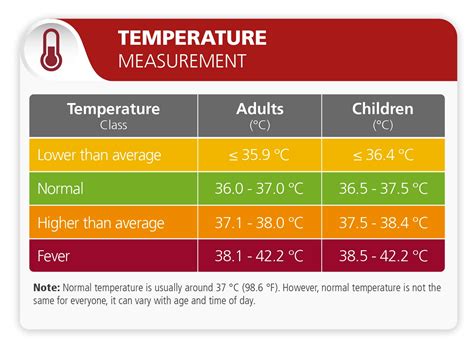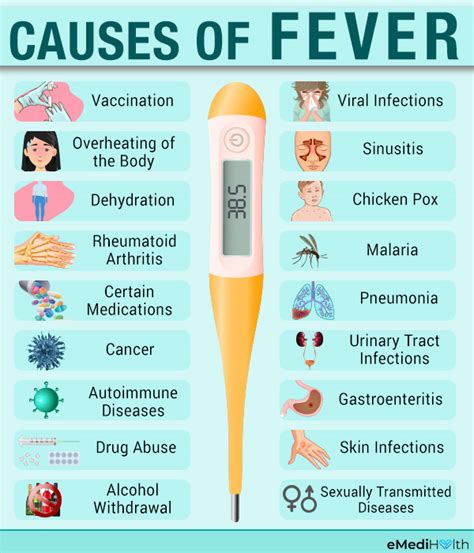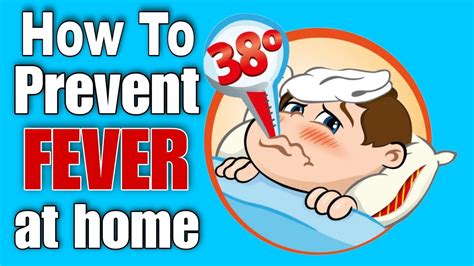Intro
Understand normal body temperature ranges with our Fever Temperature Guide, covering low-grade fever, high fever, and fever reduction methods, including temperature monitoring and management techniques for adults and children.
When it comes to our health, there's nothing more alarming than a sudden spike in body temperature, commonly known as a fever. Fevers can be unsettling, especially for parents of young children or individuals with compromised immune systems. Understanding the intricacies of fever temperature is crucial for identifying the underlying cause and seeking appropriate medical attention. In this article, we will delve into the world of fever temperatures, exploring the various aspects, from the definition and types of fevers to their causes, symptoms, and treatment options.
Fever is a natural response of the body's immune system to infection or inflammation. It's a sign that the body is fighting off an invader, whether it's a virus, bacteria, or other foreign substances. The average body temperature is around 98.6°F (37°C), but it can vary slightly from person to person. When the body temperature rises above this normal range, it's considered a fever. Fevers can be mild, moderate, or severe, and their severity often depends on the underlying cause.
The importance of understanding fever temperatures cannot be overstated. Recognizing the signs and symptoms of a fever can help individuals seek medical attention promptly, which is critical in preventing complications and promoting recovery. Moreover, knowing how to manage fever temperatures can alleviate discomfort, reduce the risk of dehydration, and support the body's natural healing process. Whether you're a concerned parent, a healthcare professional, or simply someone interested in learning more about fever temperatures, this article aims to provide a comprehensive guide to help you navigate the complex world of fevers.
Understanding Fever Temperatures

Fever temperatures can be classified into different categories, depending on their severity. A low-grade fever typically ranges from 100.4°F (38°C) to 102.2°F (39°C), while a moderate fever can reach temperatures between 102.3°F (39.1°C) and 104°F (40°C). High fevers, on the other hand, exceed 104°F (40°C) and can be a cause for concern. It's essential to note that fever temperatures can fluctuate throughout the day, and their severity may vary depending on the individual's age, overall health, and underlying medical conditions.
Types of Fevers
There are several types of fevers, each with distinct characteristics and underlying causes. Some common types of fevers include: * Continuous fever: remains relatively constant throughout the day * Remittent fever: fluctuates but never returns to normal * Intermittent fever: recurs at regular intervals * Relapsing fever: recurs after a period of normal temperature * Septic fever: associated with a severe infection, such as sepsisCauses of Fever

Fever can be caused by a wide range of factors, including:
- Infections: viral, bacterial, fungal, or parasitic
- Inflammation: tissue damage, injury, or autoimmune disorders
- Immune system disorders: allergies, asthma, or rheumatoid arthritis
- Medications: certain antibiotics, antihistamines, or vaccines
- Environmental factors: heat stroke, sun exposure, or extreme cold
Symptoms of Fever
The symptoms of fever can vary depending on the underlying cause and individual factors. Common symptoms include: * Elevated body temperature * Chills or sweating * Headache or body aches * Fatigue or weakness * Loss of appetite or nausea * Irritability or confusionTreatment Options for Fever

Treatment for fever typically focuses on managing symptoms, addressing the underlying cause, and preventing complications. Some common treatment options include:
- Over-the-counter medications: acetaminophen or ibuprofen
- Prescription medications: antibiotics or antiviral medications
- Rest and hydration: staying hydrated and getting plenty of rest
- Cooling measures: cool compresses, cool baths, or fans
- Medical attention: seeking medical help if symptoms worsen or persist
Home Remedies for Fever
In addition to medical treatment, there are several home remedies that can help alleviate fever symptoms. Some of these remedies include: * Staying hydrated: drinking plenty of fluids, such as water, clear broth, or electrolyte-rich beverages * Resting: getting plenty of rest to help the body recover * Using cool compresses: applying cool, damp cloths to the forehead, wrists, or neck * Taking warm baths: soaking in a warm bath to help bring down the temperature * Practicing good hygiene: washing hands frequently, avoiding close contact with others, and avoiding sharing utensils or personal itemsPreventing Fever

While it's not always possible to prevent fever, there are several steps that can be taken to reduce the risk of getting sick. Some of these measures include:
- Practicing good hygiene: washing hands frequently, avoiding close contact with others, and avoiding sharing utensils or personal items
- Getting vaccinated: staying up-to-date on recommended vaccinations, such as flu shots or pneumonia vaccines
- Avoiding close contact: avoiding close contact with individuals who are sick
- Staying hydrated: drinking plenty of fluids to help keep the immune system strong
- Getting plenty of rest: getting enough sleep to help the body recover from illness
Fever in Special Populations
Fever can affect anyone, but certain populations are more vulnerable to complications. These include: * Infants and young children: fever can be a sign of a serious infection in young children * Older adults: fever can be a sign of a underlying medical condition, such as pneumonia or sepsis * People with compromised immune systems: fever can be a sign of a serious infection in individuals with weakened immune systems * Pregnant women: fever can be a sign of a underlying medical condition, such as pregnancy-related complicationsConclusion and Next Steps

In conclusion, understanding fever temperatures is crucial for identifying the underlying cause and seeking appropriate medical attention. By recognizing the signs and symptoms of fever, individuals can take steps to manage their symptoms, address the underlying cause, and prevent complications. Whether you're a concerned parent, a healthcare professional, or simply someone interested in learning more about fever temperatures, this article aims to provide a comprehensive guide to help you navigate the complex world of fevers. We encourage you to share your thoughts, experiences, and questions in the comments section below. If you found this article helpful, please consider sharing it with others who may benefit from this information.
What is a normal body temperature?
+A normal body temperature is around 98.6°F (37°C), but it can vary slightly from person to person.
What are the symptoms of fever?
+Common symptoms of fever include elevated body temperature, chills or sweating, headache or body aches, fatigue or weakness, and loss of appetite or nausea.
How can I treat a fever at home?
+Treatment for fever typically focuses on managing symptoms, addressing the underlying cause, and preventing complications. Home remedies include staying hydrated, resting, using cool compresses, taking warm baths, and practicing good hygiene.
